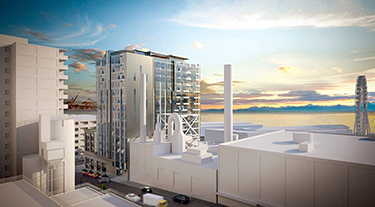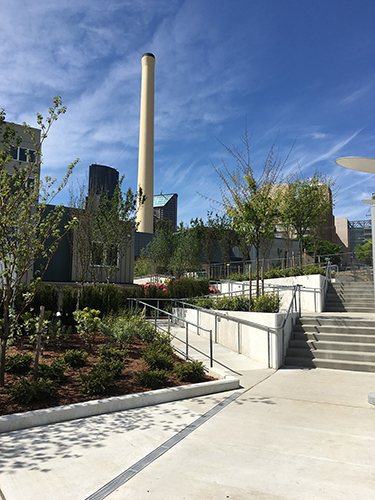|
Subscribe / Renew |
|
|
Contact Us |
|
| ► Subscribe to our Free Weekly Newsletter | |
| home | Welcome, sign in or click here to subscribe. | login |
News
| |

|
|
Design Perspectives By Clair Enlow |
June 8, 2016
Design Perspectives -- District energy: Lots of talk, but still little action
Special to the Journal
At the corner of University Street and Western Avenue, Cyrene just topped out at 17 stories. Mack Urban's mixed-use project fills a longtime gap between Harbor Steps and the waterfront.
For now, Cyrene stands beside the Alaskan Way Viaduct — ready for the moment when that highway structure comes down and waterfront redevelopment begins in earnest. When that happens, Cyrene will breathe free.
The new tower is permanently tied to its next door neighbor to the north: the Enwave Seattle (formerly Seattle Steam) plant. Cyrene will get steam heat directly from the plant, just like about 200 other Seattle buildings already do.
But this will be a two-way connection. Leftover heat from Cyrene will go directly back to Enwave Seattle in the form of condensate (warm water), making the job of Enwave Seattle's boilers just a little easier. All that excess heat from Cyrene won't be lost, and the connection will save lots of energy and money over time.
District energy is one of the keys to making cities sustainable, and it's getting new legs in Seattle. Architects and others interested in these systems gathered last month across the street from Cyrene in the office of DLR Group to learn more.
The definition of district energy is changing and expanding, but it involves sharing heat, cooling and/or power from one source with one or more separate buildings. A heat-only boiler station like Enwave Seattle's is a typical source.
Are we too late?
DLR Group's Rico Quirindongo wants to see more district energy hookups as the new waterfront neighborhood takes shape. “When someone starts ripping up streets, we've already missed the opportunity,” he said.
Enwave Seattle, a private utility with over a century of history, is even more sustainable now because it has revised its boiler systems to use biofuel (wood chips, mostly a waste product) instead of gas.
Mack Urban's Martha Barkman said Cyrene connected with Enwave's system for several reasons — including that the plant is just inches away. The project got some permitting breaks from the city of Seattle, like larger windows and less insulation, along with credit for saving heat.
There were upfront costs in connecting to the private utility, according to Barkman, but they will be more than offset over time by lower maintenance and energy costs. The system takes up little space inside Cyrene, and there's no cooling tower on the roof. Occupants will get quiet, consistent heat and better air quality, she said.
Just up the hill and across Western Avenue is the Four Seasons Hotel, built in 2008 and also connected to the Enwave plant. The plant is welcoming some return customers, according to Enwave's Marco Lowe, like The Roosevelt Hotel. The hotel was heated by Seattle Steam when it was built in 1929, then detached for its own system in the 1980s. It is now being remodeled for a new era and hooking up again with Enwave Seattle.
District energy has been around for a long time. Enwave Seattle supplies heat to big users like hospitals. College campuses in Seattle and in other cities typically have own their own plant.
Now experts and Seattle officials agree that district energy is a key to carbon-neutrality, a goal embraced by the city as well as environmental groups. Technologies continue to develop for capturing and reusing heat from many sources in the natural and built environments.
And owners have new ways to look for partners. Seattle 2030 District is a public/private consortium focused on sustainable construction and development. Director Susan Wickwire said the most important point for would-be district energy participants is that the source of energy — whether it's a plant or just a building with extra heat — is committed to the connection, and likely to be around for a long time.
Vancouver ahead
Spurred by a special Canadian tax on greenhouse emissions, Vancouver, B.C., may be ahead of Seattle in the race for district heating. The University of British Columbia has a rapidly improving district system, and Vancouver's historic downtown district energy source is upgrading and expanding.
Prior to the 2010 Winter Olympics, the city launched a system called False Creek Neighborhood Energy Utility. Today wastewater pipes supply 70 percent of the energy used for the neighborhood system; gas boilers are there only for backup in the winter months.
Cold European cities like Copenhagen, London and Helsinki have networks of connected buildings that store and share heat. But unlike European cities, Seattle cannot legally compel owners to hook up to a district system.
Raising the bar
Seattle has great intentions, but not a lot of new district energy hookups to show for them, even though it's in the middle of a historic construction boom. Some developers say they just don't have enough reasons.
Seattle City Councilmember Mike O'Brien said they may be right. City officials face competing goals. Incentive zoning supports affordable housing, a stated priority on Mayor Ed Murray's agenda.
A new energy code for Seattle is due this summer, and it will likely raise the bar for energy efficiency and waste heat recovery in different building types, something that can only encourage investments in district energy.
In the meantime, hooking up to district energy — or even preparing to do so in the future — is still likely to pay off in the long run.
And the definition of district energy is changing, with the accent on recovery and sharing. All it takes is two or more buildings, and all buildings have heat that's going to waste.
Residential and commercial buildings are ideal partners because their needs peak at different times of day. But some are hotter than others.
A data center is an ideal source of excess energy in the form of waste heat. The heat-producing Westin Building Exchange supplies thermal energy to Amazon.com's emerging campus in the Denny Triangle. With the help of Amazon's development partner Seneca Group, plus permitting support from the city, the system is already serving the first of Amazon's new towers.
Westin Building Exchange is a 34-story data center at 2001 Sixth Ave. Though it was built as an office tower, much of it is now filled with cabling and servers, according to Sabrina Villanueva of Clise Properties, which owns the data center. In the data center's previous mechanical system, water was stored on the roof and circulated into the building for cooling. Heated water went back to the roof, where it just waited to evaporate.
Now, hot water goes under Sixth Avenue to one of Amazon's new towers. Like Cyrene and other new buildings with district heating, the Amazon buildings have a hydronic (water circulation) heating system.
Engineering the shared system is not so novel, according to Ash Awad of McKinstry, which designed and built the system. The real challenge was getting pipes to cross under the street, where private landowners just don't go. McKinstry and Clise Properties created a kind of private utility, Eco District, which owns the shared infrastructure.
Awad said interested owners and developers can prepare for the day when they'll connect to some district energy source by building a water-based system.
There's still energy to spare in the Denny Triangle. Of the 11 megawatts of energy (in the form of heat) produced by the Westin Building Exchange, Amazon is using only 5 megawatts per day — not even half. That leaves a lot of energy for future hookups.
Clair Enlow can be reached by e-mail at clair@clairenlow.com.
Previous columns:
- Design Perspectives: New paths and parks make Yesler Terrace shine, 05-04-2016
- Design Perspectives: Cities improving streets with paint, and political will, 04-06-2016
- Design Perspectives -- WSCC expansion: So what's inside the box?, 03-09-2016
- Design Perspectives: UW eyes 8 million square feet of new buildings, 02-17-2016
- AIA winners manage to surprise and inspire, 11-18-2015
- Design Perspectives: 2&U tower's design team attempts a heavy lift, 11-12-2015
- Design Perspectives: Budapest, Vienna offer lessons on planning and war, 09-30-2015
- Design Perspectives: Two Seattle tower designs that flaunt their height, 08-26-2015




